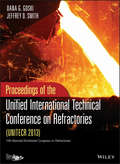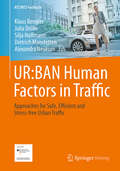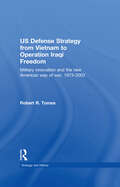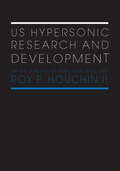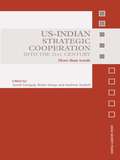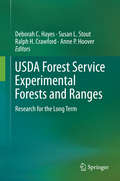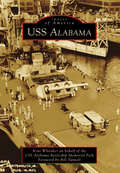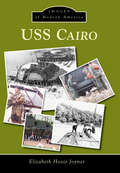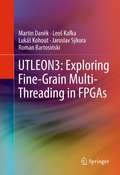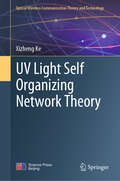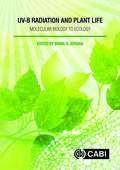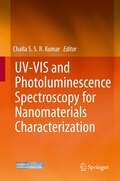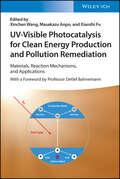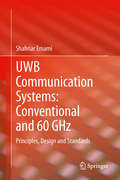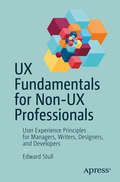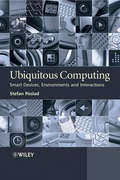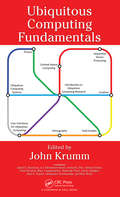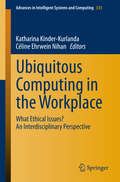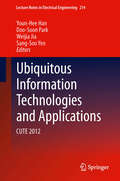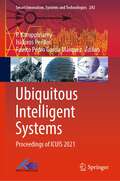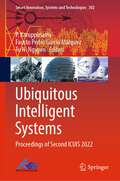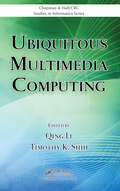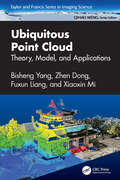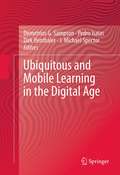- Table View
- List View
UNDERSTANDING THE BENEFITS AND RISKS OF PHARMACEUTICALS: Workshop Summary
by Institute of Medicine of the National AcademiesThe National Academies Press (NAP)--publisher for the National Academies--publishes more than 200 books a year offering the most authoritative views, definitive information, and groundbreaking recommendations on a wide range of topics in science, engineering, and health. Our books are unique in that they are authored by the nation's leading experts in every scientific field.
UNITECR 2013: Proceedings of the Unified International Technical Conference on Refractories
by Dana Goski Jeffrey D. SmithProceedings containing 231 manuscripts that were submitted and approved for the 13th biennial worldwide refractories congress recognized as the Unified International Technical Conference on Refractories(UNITECR), held September 10-13, 2013.
UR:BAN Human Factors in Traffic
by Klaus Bengler Julia Drüke Silja Hoffmann Dietrich Manstetten Alexandra NeukumThis book gives a unique insight in approaches that optimize driver assistance and driver information systems for the urban usage. Furthermore innovative test regimes for controllability testing and new evaluation techniques like networked simulators and virtual reality test-beds are described including statistical methodologies.
US Defence Strategy from Vietnam to Operation Iraqi Freedom: Military Innovation and the New American War of War, 1973-2003 (Strategy and History)
by Robert R. TomesUS Defence Strategy from Vietnam to Operation Iraqi Freedom examines the thirty-year transformation in American military thought and defence strategy that spanned from 1973 through 2003. During these three decades, new technology and operational practices helped form what observers dubbed a 'Revolution in Military Affairs' in the 1990s and a 'New American Way of War' in the 2000s. Robert R. Tomes tells for the first time the story of how innovative approaches to solving battlefield challenges gave rise to non-nuclear strategic strike, the quest to apply information technology to offset Soviet military advantages, and the rise of 'decisive operations' in American military strategy. He details an innovation process that began in the shadow of Vietnam, matured in the 1980s as Pentagon planners sought an integrated nuclear-conventional deterrent, and culminated with battles fought during blinding sandstorms on the road to Baghdad in 2003. An important contribution to military innovation studies, the book also presents an innovation framework applicable to current defence transformation efforts. This book will be of much interest to students of strategic studies, US defence policy and US politics in general.
US Hypersonic Research and Development: The Rise and Fall of 'Dyna-Soar', 1944-1963 (Space Power and Politics)
by Roy F. Houchin IIAn essential new account of some of the most valuable research and development in international military history. Roy F. Houchin II shows how the roots of US Air Force hypersonic research and development are grounded in Army Air Force General Henry H. 'Hap' Arnold's identification of the need for advanced airpower weapon systems to meet the anticipated postwar enemy threat. The technology for a smooth transition to military spaceflight seemed within reach when Bell Aircraft Corporation executive Walter Dornberger (the former commander of Nazi Germany's V-2 rocket research) made an unsolicited proposal to William E. Lamar (the chief of Wright Aeronautical Development Center's New Development Office of the Bomber Aircraft Division at Wright-Patterson AFB, OH) for a hypersonic boost-glide weapon system. Visionaries like Arnold, Dornberger, and Lamar believed a hypersonic boost-glider would represent the ultimate expression of the US Air Force's doctrine by performing strategic bombardment and reconnaissance more successfully any other type of vehicle. As this aspiration reached maturity in Dyna-Soar, the service's leadership never gave up their beliefs. This book shows how the struggle to persuade the secretary of defence and his advisors, who did not share the Air Force's vision for a military spaceplane, illustrates the ebb and flow of an advanced technology program and its powerful legacy within American society.
US-Indian Strategic Cooperation into the 21st Century: More than Words (Asian Security Studies)
by Sumit Ganguly Andrew Scobell Brian ShoupIn this edited book, leading scholars and analysts trace the origins, evolution and the current state of Indo-US strategic cooperation. During the Cold War, owing to opposing grand strategies, the two states frequently found themselves at odds. With the end of the Cold War and the demise of the Soviet Union, Indo-US security cooperation started in a fitful fashion, but in recent years it has acquired considerable stability. The armed forces of the two states have participated in exercises on land, sea and air and have also carried out joint humanitarian missions. Drawing on new information and with contributions from both academics and policy makers, this wide-ranging volume analyzes the strategic convergence of the world’s two largest democracies, whilst explaining why important differences do remain. These notably include questions pertaining to the future of India’s nuclear and ballistic missile programs, US-Pakistan ties and India’s links with Iran. This volume will be of great interest to students of South Asian politics, Asian security, US foreign policy and security studies in general.
USDA Forest Service Experimental Forests and Ranges
by Deborah C. Hayes Susan L. Stout Ralph H. Crawford Anne P. HooverUSDA Forest Service Experimental Forests and Ranges (EFRs) are scientific treasures, providing secure, protected research sites where complex and diverse ecological processes are studied over the long term. This book offers several examples of the dynamic interactions among questions of public concern or policy, EFR research, and natural resource management practices and policies. Often, trends observed - or expected -- in the early years of a research program are contradicted or confounded as the research record extends over decades. The EFRs are among the few areas in the US where such long-term research has been carried out by teams of scientists. Changes in society's needs and values can also redirect research programs. Each chapter of this book reflects the interplay between the ecological results that emerge from a long-term research project and the social forces that influence questions asked and resources invested in ecological research. While these stories include summaries and syntheses of traditional research results, they offer a distinctly new perspective, a larger and more complete picture than that provided by a more typical 5-year study. They also provide examples of long-term research on EFRs that have provided answers for questions not even imagined at the time the study was installed.
USS Alabama (Images of America)
by Kent Whitaker USS Alabama Battleship Memorial Park Bill TunnellPowerful: this single word aptly describes a naval vessel known as a battleship. The USS Alabama (BB-60) was the last of four South Dakota-class battleships built for World War II. She is well armored and designed to survive an attack while continuing to fight. Her main battery, known as "Big Guns," consisted of nine 16-inch guns; each could launch a projectile weighing as much as a small car that could hit a target 21 miles away. Her crew numbered 2,332 men, none of whom were lost to enemy fire, earning her the nickname "Lucky A." She served as more than just a battleship: she carried troops, supplies, and seaplanes and served in the Pacific and Atlantic; her doctors treated patients from other ships; she was the wartime home for a major-league ballplayer; the movie setting for Hollywood films; and she traveled home to the state of Alabama with the help of schoolchildren.
USS Cairo: History And Artifacts Of A Civil War Gunboat (Images of Modern America)
by Elizabeth Hoxie JoynerArmed with a simple pocket compass, a small boat, and an intense desire to find the USS Cairo, three men--Edwin C. Bearss, Warren Grabau, and Max Don Jacks--set out on the Yazoo River on a cool autumn afternoon in 1956 to locate the Civil War gunboat. What they found was the discovery of a lifetime. Images of Modern America: USS Cairo features a photographic account of the discovery, raising, restoration, and preservation efforts surrounding the Cairo. One can sense the excitement and awe felt by people who witnessed the raising. Today, people from all over the world are drawn to visit this Civil War time capsule now in permanent dry dock at Vicksburg National Military Park, where commemorative events have occurred since 1980; this collection highlights a variety of these events.
UTLEON3: Exploring Fine-Grain Multi-Threading in FPGAs
by Martin Daněk Lukáš Kohout Jaroslav Sýkora Roman Bartosiński Leoš KafkaThis book describes a specification, microarchitecture, VHDL implementation and evaluation of a SPARC v8 CPU with fine-grain multi-threading, called micro-threading. The CPU, named UTLEON3, is an alternative platform for exploring CPU multi-threading that is compatible with the industry-standard GRLIB package. The processor microarchitecture was designed to map in an efficient way the data-flow scheme on a classical von Neumann pipelined processing used in common processors, while retaining full binary compatibility with existing legacy programs.
UV Light Self Organizing Network Theory (Optical Wireless Communication Theory and Technology)
by Xizheng KeThis book covers the basic concepts of UV communication, the analysis of UV channel characteristics, the organize media access protocols, and routing protocols, etc. in the network. Based on the analysis of classical communication protocols, a basic framework for UV self-organising networks is proposed. The communication protocol proposed in the book is analyzed in detail, and the key procedures of computer simulation are given at the end of the book so that readers can learn and understand.This book can guide senior undergraduate and postgraduate students of communications, networking, and other related majors in colleges and universities. It can also be used as a reference book for researchers and engineering technicians.
UV-B Radiation and Plant Life: Molecular Biology to Ecology
by Marcel Jansen Pedro J. Aphalo Amy T. Austin Carlos L. Ballaré Paul W. Barnes Susanne Baldermann Melanie Binkert Janet F. Bornman Isabelle N. Bottger Stephan D. Flint Franziska S. Hanschen Éva Hideg Gareth I. Jenkins Karel Klem Susanne Neugart Monika Schreiner Åke Strid Mark A. Tobler Roman Ulm Otmar Urban Jason Wargent Melanie WiesnerUltraviolet-B radiation (UV-B) has profound effects on plant growth and development, and exposure varies with ozone depletion and across geographic regions, with ecosystem and agricultural consequences. This book deals with large-scale impacts but also how UV-B affects plants at the molecular level is also fascinating, and the UV-B photoreceptor has only recently been characterised. While UV-B radiation can be damaging, it also has a more positive role in plant photomorphogenesis. Consequently UV-B treatments are being developed as innovative approaches to improve horticulture. This book is a timely synthesis of what we know and need to know about UV-B radiation and plants.
UV-VIS and Photoluminescence Spectroscopy for Nanomaterials Characterization
by Challa S.S.R. KumarSecond volume of a 40-volume series on nanoscience and nanotechnology, edited by the renowned scientist Challa S.S.R. Kumar. This handbook gives a comprehensive overview about UV-visible and photoluminescence spectroscopy for the characterization of nanomaterials. Modern applications and state-of-the-art techniques are covered and make this volume essential reading for research scientists in academia and industry in the related fields.
UV-Visible Photocatalysis for Clean Energy Production and Pollution Remediation: Materials, Reaction Mechanisms, and Applications
by Masakazu Anpo Xianzhi Fu Xinchen WangUV-Visible Photocatalysis for Clean Energy Production and Pollution Remediation Comprehensive resource detailing fundamentals of photocatalysis, clean energy production, and pollution treatment, as well as recent developments in each field UV-Visible Photocatalysis for Clean Energy Production and Pollution Remediation: Materials, Reaction Mechanisms, and Applications provides current developments in photocatalytic reactions for both inorganic and organic-based materials which operate under UV-visible light or sunlight irradiation, with a focus on the fundamentals and applications in clean energy production and pollution remediation. The text curates interesting and important research surrounding photocatalysis for hydrogen production, including the fundamentals and photocatalytic remediation of our better environments, which covers the reduction of CO2 and fixation of N2 with H2O under UV-visible light or sunlight irradiation. The first chapter of the book introduces these diverse subjects by including a brief history of the developments of photocatalysis research since around the 1960s. Specific sample topics covered in this book include: Visible-light active photocatalysts in pollutant degradation and conversion with simultaneous hydrogen production Application of S-scheme heterojunction photocatalyst and the role of the defects on the photocatalytic reactions on ZnO Strategies for promoting overall water splitting with particulate photocatalysts via single-step visible-light photoexcitation Polymeric carbon nitride-based materials in aqueous suspensions for water photo-splitting and photo-reforming of biomass aqueous solutions to generate H2 Visible light-responsive TiO2 thin film photocatalysts for the separate evolution of H2 and O2 from water For chemists, scientists, physicists, and engineers across a wide range of disciplines, UV-Visible Photocatalysis for Clean Energy Production and Pollution Remediation is an essential resource for understanding current developments in photocatalytic reactions on both inorganic and organic-based materials which operate under UV-visible light or sunlight irradiation.
UWB Communication Systems: Conventional and 60 GHz
by Shahriar EmamiIn this book the author examines 60 GHz and conventional UWB. The book introduces the fundamentals, architectures, and applications of unified ultra wideband devices. The material includes both theory and practice and introduces ultra wideband communication systems and their applications in a systematic manner. The material is written to enable readers to design, analyze, and evaluate UWB communication systems.
UX Fundamentals for Non-UX Professionals: User Experience Principles for Managers, Writers, Designers, and Developers
by Edward StullDemystify UX and its rules, contradictions, and dilemmas. This book provides real-world examples of user experience concepts that empower teams to create compelling products and services, manage social media, interview UX candidates, and oversee product teams.From product decisions to performance reviews, your ability to participate in discussions about UX has become vital to your company's success as well as your own. However, UX concepts can seem complex. Many UX books are written by and for UX professionals. UX Fundamentals for Non-UX Professionals serves the needs of project managers, graphic designers, copyeditors, marketers, and others who wish to understand UX design and research.You will discover how UX has influenced history and continues to affect our daily lives. Entertaining real-world examples demonstrate what a massive, WWII-era tank teaches us about design, what a blue flower tells us about audiences, and what drunk marathoners show us about software.What You'll LearnKnow the fundamentals of UX through real-world examples Acquire the skills to participate intelligently in discussions about UX design and researchUnderstand how UX impacts business, including product, pricing, placement, and promotion as well as security, speed, and privacyWho This Book Is ForProfessionals who work alongside UX designers and researchers, including but not limited to: project managers, graphic designers, copyeditors, developers, and human resource professionals; and business, marketing, and computer science students seeking to understand how UX affects human cognition and memory, product pricing and promotion, and software security and privacy.
Ubiquitous Computing
by Stefan PosladThis book provides an introduction to the complex field of ubiquitous computingUbiquitous Computing (also commonly referred to as Pervasive Computing) describes the ways in which current technological models, based upon three base designs: smart (mobile, wireless, service) devices, smart environments (of embedded system devices) and smart interaction (between devices), relate to and support a computing vision for a greater range of computer devices, used in a greater range of (human, ICT and physical) environments and activities. The author details the rich potential of ubiquitous computing, the challenges involved in making it a reality, and the prerequisite technological infrastructure. Additionally, the book discusses the application and convergence of several current major and future computing trends. Key Features:Provides an introduction to the complex field of ubiquitous computingDescribes how current technology models based upon six different technology form factors which have varying degrees of mobility wireless connectivity and service volatility: tabs, pads, boards, dust, skins and clay, enable the vision of ubiquitous computingDescribes and explores how the three core designs (smart devices, environments and interaction) based upon current technology models can be applied to, and can evolve to, support a vision of ubiquitous computing and computing for the futureCovers the principles of the following current technology models, including mobile wireless networks, service-oriented computing, human computer interaction, artificial intelligence, context-awareness, autonomous systems, micro-electromechanical systems, sensors, embedded controllers and robotsCovers a range of interactions, between two or more UbiCom devices, between devices and people (HCI), between devices and the physical world.Includes an accompanying website with PowerPoint slides, problems and solutions, exercises, bibliography and further readingGraduate students in computer science, electrical engineering and telecommunications courses will find this a fascinating and useful introduction to the subject. It will also be of interest to ICT professionals, software and network developers and others interested in future trends and models of computing and interaction over the next decades.
Ubiquitous Computing Fundamentals
by John Krumm"…a must-read text that provides a historical lens to see how ubicomp has matured into a multidisciplinary endeavor. It will be an essential reference to researchers and those who want to learn more about this evolving field." -From the Foreword, Professor Gregory D. Abowd, Georgia Institute of Technology First introduced two decades ago, the term ubiquitous computing is now part of the common vernacular. Ubicomp, as it is commonly called, has grown not just quickly but broadly so as to encompass a wealth of concepts and technology that serves any number of purposes across all of human endeavor. While such growth is positive, the newest generation of ubicomp practitioners and researchers, isolated to specific tasks, are in danger of losing their sense of history and the broader perspective that has been so essential to the field’s creativity and brilliance. Under the guidance of John Krumm, an original ubicomp pioneer, Ubiquitous Computing Fundamentals brings together eleven ubiquitous computing trailblazers who each report on his or her area of expertise. Starting with a historical introduction, the book moves on to summarize a number of self-contained topics. Taking a decidedly human perspective, the book includes discussion on how to observe people in their natural environments and evaluate the critical points where ubiquitous computing technologies can improve their lives. Among a range of topics this book examines: How to build an infrastructure that supports ubiquitous computing applications Privacy protection in systems that connect personal devices and personal information Moving from the graphical to the ubiquitous computing user interface Techniques that are revolutionizing the way we determine a person’s location and understand other sensor measurements While we needn’t become expert in every sub-discipline of ubicomp, it is necessary that we appreciate all the perspectives that make up the field and understand how our work can influence and be influenced by those perspectives. This is important, if we are to encourage future generations to be as successfully innovative as the field’s originators.
Ubiquitous Computing in the Workplace: What Ethical Issues? An Interdisciplinary Perspective (Advances in Intelligent Systems and Computing #333)
by Katharina Kinder-Kurlanda Céline Ehrwein NihanThis book provides an interdisciplinary collection of views on the ethical challenges and opportunities of workplaces in the Internet of things. Current developments within Ubiquitous computing (ubicomp) systems designed for the workplace are introduced and philosophical, organizational and socio-ethical considerations of ubicomp in workplaces are provided. Suggestions regarding the rules that should be respected in order to favor an adequate implementation of ubicomp in the workplace are offered, considering both intra-organizational but also wider societal concerns. The interdisciplinary collection of contributions invites the reader to engage in the discussion of ubicomp in everyday working environments.
Ubiquitous Information Technologies and Applications
by Sang-Soo Yeo Doo-Soon Park Weijia Jia Youn-Hee HanRecent advances in electronic and computer technologies have paved the way for the proliferation of ubiquitous computing and innovative applications that incorporate these technologies. This proceedings book describes these new and innovative technologies, and covers topics like Ubiquitous Communication and Networks, Security Systems, Smart Devices and Applications, Cloud and Grid Systems, Service-oriented and Web Service Computing, Embedded Hardware and Image Processing and Multimedia.
Ubiquitous Intelligent Systems: Proceedings of ICUIS 2021 (Smart Innovation, Systems and Technologies #243)
by Fausto Pedro García Márquez Isidoros Perikos P. KaruppusamyThis book features a collection of high-quality, peer-reviewed papers presented at International Conference on Ubiquitous Intelligent Systems (ICUIS 2021) organized by Shree Venkateshwara Hi-Tech Engineering College, Tamil Nadu, India, during April 16–17, 2021. The book covers topics such as cloud computing, mobile computing and networks, embedded computing frameworks, modeling and analysis of ubiquitous information systems, communication networking models, big data models and applications, ubiquitous information processing systems, next-generation ubiquitous networks and protocols, advanced intelligent systems, Internet of things, wireless communication and storage networks, intelligent information retrieval techniques, AI-based intelligent information visualization techniques, cognitive informatics, smart automation systems, healthcare informatics and bioinformatics models, security and privacy of intelligent information systems, and smart distributed information systems.
Ubiquitous Intelligent Systems: Proceedings of Second ICUIS 2022 (Smart Innovation, Systems and Technologies #302)
by Fausto Pedro García Márquez P. Karuppusamy Tu N. NguyenThis book features a collection of high-quality, peer-reviewed papers presented at the Second International Conference on Ubiquitous Intelligent Systems (ICUIS 2022) organized by Shree Venkateshwara Hi-Tech Engineering College, Tamil Nadu, India, during March 10–11, 2022. The book covers topics such as cloud computing, mobile computing and networks, embedded computing frameworks, modeling and analysis of ubiquitous information systems, communication networking models, big data models and applications, ubiquitous information processing systems, next-generation ubiquitous networks and protocols, advanced intelligent systems, Internet of Things, wireless communication and storage networks, intelligent information retrieval techniques, AI-based intelligent information visualization techniques, cognitive informatics, smart automation systems, health care informatics and bioinformatics models, security and privacy of intelligent information systems, and smart distributed information systems.
Ubiquitous Multimedia Computing (Chapman & Hall/CRC Studies in Informatics Series)
by Qing Li Timothy K. ShinComputing is ubiquitous and if you think otherwise, that in itself might be the best evidence that it is so. Computers are omnipresent in modern life and the multimedia computing environment of today is becoming more and more seamless.Bringing together contributions from dozens of leading experts, Ubiquitous Multimedia Computing educates readers on
Ubiquitous Point Cloud: Theory, Model, and Applications (Imaging Science)
by Bisheng Yang Zhen Dong Fuxun Liang Xiaoxin MiPoint clouds from LiDAR and photogrammetry are vital and vast sources of geospatial information besides remote sensing imagery. This book provides the latest theory and methodology for point cloud processing with AI to better serve earth observation, 3D vision, autonomous driving, smart city, and geospatial information applications. It covers various aspects of 3D geospatial information, including data capturing, fusing, geocomputing, modeling, and vast downstream applications. With the inclusion of numerous illustrations, diagrams, and practical applications, readers will better understand the point cloud, and its technical challenges, and learn how to utilize point cloud in different fields.Features Provides in-depth point cloud processing pipeline, cutting-edge theory, and technology with AI. Includes many specific applications of point cloud in the geospatial field. Offers a comprehensive step-by-step guide from theory to application in point cloud processing. Includes ample supplementary materials including datasets, tools, and other online resources. Helps readers across many disciplines, from geospatial to engineering, to understand the vast application of point clouds and how to further generate new ideas and innovative thoughts. This book is an excellent resource for researchers, academics, students, and professionals in a variety of fields including Geomatics, Remote Sensing, Cartography and Geographic Information Systems, Data Science, Geography, Earth Science, and more.
Ubiquitous and Mobile Learning in the Digital Age
by Dirk Ifenthaler J. Michael Spector Pedro Isaias Demetrios G. SampsonThis edited volume with selected expanded papers from CELDA (Cognition and Exploratory Learning in the Digital Age) 2011 (http://www.celda--conf.org/) will focus on Ubiquitous and Mobile Informal and Formal Learning in the Digital Age, with sub-topics: Mobile and Ubiquitous Informal and Formal Learning Environments (Part I), Social Web Technologies for new knowledge representation, retrieval, creation and sharing in Informal and Formal Educational Settings (Part II), Virtual Worlds and Game--based Informal and Formal Learning (Part III), Location--based and Context-- Aware Environments for Formal and Informal Learning Integration (Part IV) There will be approximately twenty chapters selected for this edited volume from among peer--reviewed papers presented at the CELDA (Cognition and Exploratory Learning in the Digital Age) 2011 Conference in Rio de Janeiro, Brazil in November, 2011.

